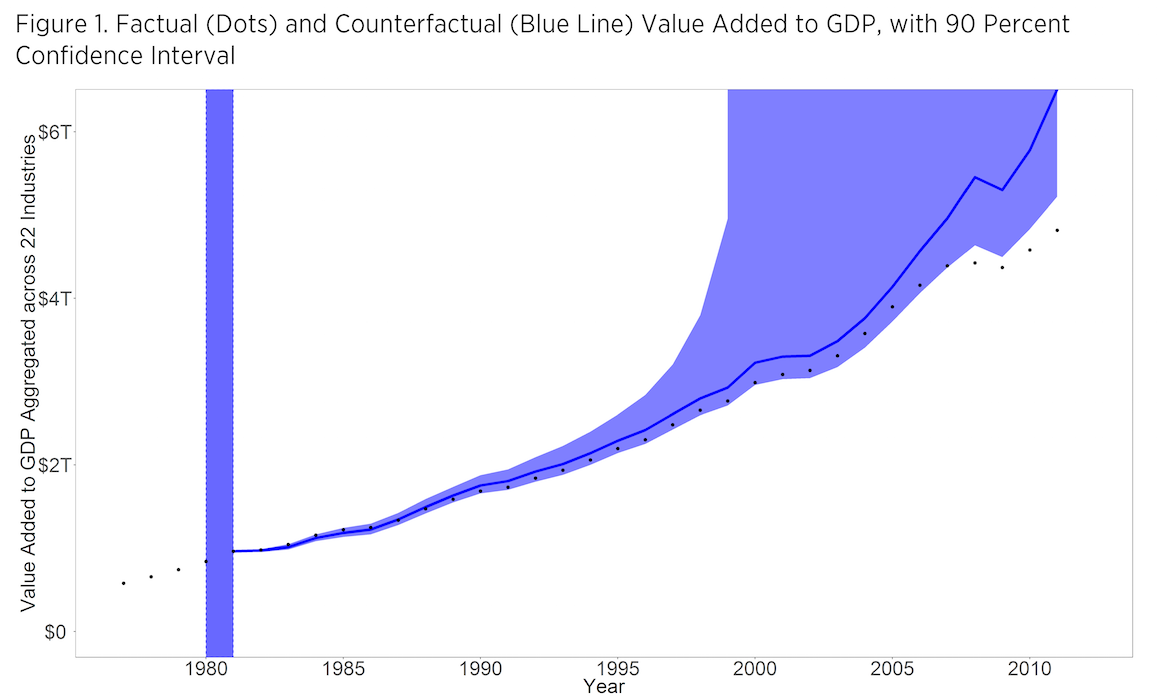By altering investment decisions and disrupting the innovation that comes from investment in knowledge creation, regulations have a cumulative and detrimental effect on economic growth—and, over time, have a real impact on American families and workers.
The impact of regulation on economic growth has been widely studied, but most research has focused on a narrow set of regulations, industries, or both. These studies typically rely on regulatory indexes that measure subsets of all regulation, on country-to-country comparisons, on short time spans, or on surveys in which experts report how regulated they believe their country or industry is. In order to better understand the cumulative cost of regulation, a comprehensive look at all regulations across many industries over a long period of time is imperative.
A new study for the Mercatus Center at George Mason University uses an economic model that examines regulation’s effect on firms’ investment choices. Using a 22-industry dataset that covers 1977 through 2012, the study finds that regulation—by distorting the investment choices that lead to innovation—has created a considerable drag on the economy, amounting to an average reduction in the annual growth rate of the US gross domestic product (GDP) of 0.8 percent.
THE PROBLEMS WITH REGULATORY ACCUMULATION
Federal regulations have accumulated over many decades, piling up over time. When regulators add more rules to the pile, analysts often consider the likely benefits and compliance costs of the additional rules.
But regulations have a greater effect on the economy than analysis of a single rule in isolation can convey. The buildup of regulations over time leads to duplicative, obsolete, conflicting, and even contradictory rules, and the multiplicity of regulatory constraints complicates and distorts the decision-making processes of firms operating in the economy. Firms respond to both individual regulations and regulatory accumulation by altering their plans for research and development, for expansion, and for updating equipment and processes. Because of the important role innovation and productivity growth play in an economy, these distortions have consequences for the growth of the economy in the long run.
KEY FINDINGS
Economic growth in the United States has, on average, been slowed by 0.8 percent per year since 1980 owing to the cumulative effects of regulation:
- If regulation had been held constant at levels observed in 1980, the US economy would have been about 25 percent larger than it actually was as of 2012.
- This means that in 2012, the economy was $4 trillion smaller than it would have been in the absence of regulatory growth since 1980.
- This amounts to a loss of approximately $13,000 per capita, a significant amount of money for most American workers.

DATA AND METHODOLOGY
The study uses a panel of 22 industries observed annually between 1977 and 2012. The authors combine data from the Bureau of Economic Analysis and the Census Bureau to measure these industries, with novel metrics of regulation by industry provided by RegData 2.2, a comprehensive, text-based quantification of industry-specific regulations in the Code of Federal Regulations. While some studies look at only one data series (such as the total quantity of regulations in the country) or attempt to compare different countries, this study’s use of 22 industries and the regulations affecting each industry provides a richer and more complete understanding of regulation’s effect on economic growth.
ENDOGENOUS GROWTH THEORY AND THE MODEL
Endogenous growth theory builds on the idea that economic growth is primarily dependent on decisions made by actors in the economy—firms and individuals—rather than on external factors.
- Economic growth is dependent on investment. Economic growth in a particular industry is determined by investment in knowledge creation, such as research and development, and the way that such investment leads to innovation and increases in productivity. This means that regulatory interventions that affect investment choices have a greater effect on the economy than the simple sum of static costs associated with regulatory compliance.
- Regulations have cumulative effects. A key insight of endogenous growth models in general is that the effect of government intervention on economic growth is not simply the sum of static costs associated with individual interventions—there are dynamic implications. The accumulation of regulation over time leads to greater and greater distortion of investment choices. Moreover, the investment choices of previous years affect growth in future years because knowledge that is not created cannot be implemented next year and the years after to be more productive.
The study develops a multisector endogenous growth model that permits a counterfactual experiment: What would have happened if federal regulation had been “frozen” at the levels observed in 1980? The model accommodates industry-specific variation in how regulation affects investment and growth, while specifying the determinants and relationships needed to estimate the long-run cost of the regulation for the economy overall.
CONCLUSIONS
While static analysis of individual regulations sometimes predicts beneficial effects for society, policymakers should consider the results of this study not only when creating new regulations, but also when considering reform of the regulatory process itself. By altering investment decisions and disrupting the innovation that comes from investment in knowledge creation, regulations have a cumulative and detrimental effect on economic growth—and, over time, have a real impact on American families and workers.
